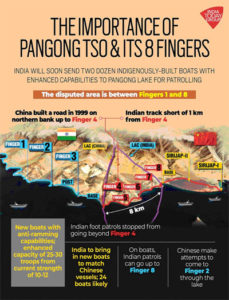Bigger Capacity High-Powered Boats On Pangong Tso Soon
December 4, 2020
Two dozen indigenously-built powerful boats with enhanced capacity to accommodate additional troops will soon make their way to the Pangong Lake, sources said. The new boats will be high speed so that they can be pressed into action and quickly intercept Chinese incursions in the lake. The boats will be used for patrolling the lake, while troops carry out foot patrols on the bank of the lake.
Two dozen indigenously-built powerful boats with anti-ramming capabilities and enhanced capacity to accommodate additional troops will soon make their way to the Pangong Lake at 14,000 feet for patrolling, sources in the security establishment said.
The Indian Army uses boats patrolling but more are required to match the capabilities and strength of the boats used by the Chinese.
“The new boats will be stronger with more capacity and are being manufactured in India,” said an official privy to the developments.
The Indian Navy was consulted about the army’s new requirements, and need to ramp up the capabilities of boats was felt amid the current standoff after skirmishes between the Indian and Chinese troops took place at the lake, sources said.

The boats are used for patrolling the lake, while troops carry out foot patrols on the bank of the lake.
Upgraded Boats
Besides strength that is essential to withstand ramming, enhanced capacity is also required to ensure more troops can be sent for patrolling in these boats.
The Chinese often engage in aggressive manoeuvres in the lake, ramming Indian boats and causing damage to them.
Currently, the boats used by India can accommodate 10-12 soldiers but this could go up to 25-30 in the new boats, similar to the capacity of the Chinese boats.
The new boats will be high speed so that they can be pressed into action and quickly intercept Chinese incursions in the lake. Sources said the new boats should be ready for deployment within a year.
The Pangong Lake will be frozen in the winter for the next three months. By next summer when the patrols in the lake resume, the new boats are expected to be deployed.
The Chinese People’s Liberation Army Ground Force (PLAGF) naval wing uses the Type 928D boats as mainstay for patrolling over occupied Pangong Tso. The boats with a length of 13m have a beam of 3.8m and a draft of 1.8m can attain the speed of almost 40knots. The boats can carry 11-18 people with a crew. They have surface radar and a remote-controlled 12.7mm anti-aircraft gun on top. The boats also have two crew-served pedestals for machine guns. They have 3 x 300 HP propulsion that provides high speed over inland waters.
Boats Key To Assert Claim In Disputed Lake
The need to upgrade boats used for patrolling the Pangong Lake was felt in wake of the military tussle between Indian and Chinese troops and the continued standoff across the Line of Actual Control in eastern Ladakh that started early May.
The confrontations began in the Pangong Lake, both in the waters and the bank, as Chinese incursions increased. Two-thirds of the 134km-long disputed lake is in Chinese control. Effectively, India controls about 45km of the lake.
The contentious area of the lake is divided into eight fingers with India claiming territory up to Finger 8. Mountain spurs jutting into the lake are referred to as fingers in military parlance to describe the features.
The face-offs happen when Indian patrols go beyond Finger 4 and the Chinese also make incursions trying to come up to Finger 2. On the northern bank of the lake that has been the focus of the current friction, the Chinese built a road till Finger 4 back in 1999 and stop Indian foot patrols from crossing it.
The Indians don’t have the luxury of a road as it ends one km before Finger 4.
In such a scenario with the standoff on the bank and mountain ridges continuing, more boats with enhanced features and capacity could be used by Indian troops to assert its claim till Finger 8, officials in the security establishment feel.
Current Tensions
India and China have been involved in an over seven-month-long tussle in Ladakh with both sides bringing in heavy deployment of troops, artillery guns, tanks and armoured vehicles in close proximity.
The tensions started with skirmishes in Pangong Lake in May when troops came to blows on more than one occasion, leaving many injured on both sides. On June 15, 20 Indian soldiers died in an ugly clash in another area called the Galwan Valley, while the Chinese never made their casualty public.
There have been eight rounds of military talks at the Corps Commander level to find a solution to the standoff but the deadlock continues.
Despite the previous talks on November 6 discussing a disengagement plan, there has been no forward movement. No further dialogue has taken place to implement measures discussed to ease out tensions.
Courtesy: Opera News/India Today

